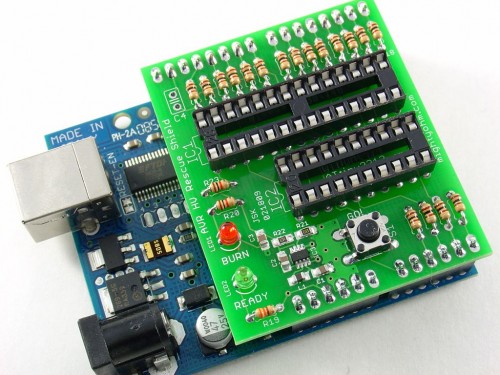
Back in March, I released the AVR HV Rescue Shield, my first open source hardware kit. The AVR HV Rescue Shield is a high voltage parallel mode fuse programmer for Atmel AVR microcontrollers.
Since then, I’ve sold dozens of kits around the world.
If you bought a kit, I want to hear from you! Specifically, I’d like feedback on the following items:
- Was the kit easy to assemble? Are the assembly instructions clear and easy to follow?
- Is the Arduino sketch easy to use? Are the usage instructions helpful?
- Are you satisfied with the kit? Does it work as advertised?
- Have you modified the kit or Arduino sketch in any way, such as adding support for more AVRs or programming modes?
- Have you taken advantage of the Open Source Hardware model or CC-licensing to re-use this design in a new and interesting way that you’d like to share?
You can leave feedback in the comments below, or if you want to respond privately, use the contact form to contact me directly.
Thanks!

Hi Jeff,
Thanks for the outstanding work! Your code worked nicely on an ATmega328p recently bricked during one of the uploading process (wouldn’t respond to ICSP programmer even with an external clock source).
Since I built my own, I chose to use a simple transistor to switch on/off the 12V source instead of using the step-up converter.
Keep up the good work!
Thanks Kerry!
The only thing i wish this thing was able to do would be to rescue 8pin AVR’s. I dont use the 2313 chips, however i do use many atmega8, and many attiny85. It would be great if i could rescue the attiny85’s too!!!
Just curious – can it program the chip in the regular way? It would be a nice addition to the shop if it could burn the fuses, then go on to program something – like a bootloader e.t.c…
At present the Rescue Shield doesn’t support flash programming, but when I did the design, I purposely included all of the necessary signals so that it could be implemented later. As far as I know, no one has tried to do it yet, but it should be possible.
The kit was a joy to assemble. The sketch worked as expected, used it to revive a bunch of Atmegas which I’d have otherwise thrown away.
Thankfully, I didn’t have to use it on other micros, but I was thinking it can be easily adapted to work on other footprints using adapters.